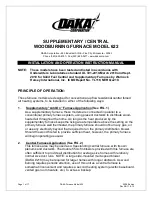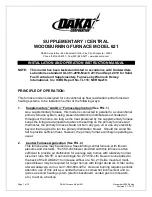
58SP0A/58SP1A: Installation, Start–Up, Operating and Service and Maintenance Instructions
Manufacturer reserves the right to change, at any time, specifications and designs without notice and without obligations.
25
GENERAL
1. Maintain 115-v wiring and ground. Improper polarity will result in
showing status code 10 and no furnace operation.
2. Make thermostat wire connections at the 24-v terminal block on the
furnace control. Failure to make proper connections will result in
improper operation, see
3. Gas supply pressure to the furnace must be greater than 4.5-in. w.c.
(0.16 psig) but not exceed 14-in. w.c. (0.5 psig).
4. Check all manual-reset switches for continuity.
5. Replace blower compartment door. Door must be in place to
operate furnace.
6. Setup switch descriptions. The variable speed furnace control has
DIP switches to select thermostat staging, blower off delay timings,
air flow selection and other operational or service related functions,
see
Start-Up Procedures
1. Purge gas lines after all connections have been made.
2. Check gas lines for leaks.
3. To Begin Component Self-Test:
a. Remove Blower Access Door.
b. Disconnect the thermostat R lead from furnace control board.
c. Manually close blower door switch.
d. Turn Setup DIP switch SW1-6 ON, see
and
NOTE:
The furnace control allows all components, except the gas
valve, to be run for short period of time. This feature helps diagnose a
system problem in case of a component failure. Component test feature
will not operate if any thermostat signal is present at the control.
Refer to service label attached to furnace (or see
).
4. Component test sequence is as follows:
a. Inducer motor starts and continues to run until Step d. of
component test sequence.
b. Hot surface igniter is energized for 15 sec., then off.
c. Blower motor operates for 15 sec.
d. After component test is completed, a status code 11 will show.
See component test section of service label (
) in furnace
for explanation of status codes.
NOTE:
To repeat component test, turn setup switch SW1-6 OFF, then
back ON.
5. Turn setup DIP switch SW1-6 OFF. Reconnect R lead to furnace
control board, release blower door switch and reinstall blower
access door.
6. Operate furnace per instruction on inner door.
7. Verify furnace shut down by lowering thermostat setting below
room temperature.
8. Verify furnace restarts by raising thermostat setting above room
temperature.
Adjustments
Furnace gas input rate on rating plate is for installations at altitudes up to
2000 Ft. (610 M). Furnace input rate must be within +/-2 percent of
furnace rating plate input.
Perform the following steps:
1. Determine the correct gas input rate.
The input rating for altitudes above 2,000 ft. (610 M) must be
reduced by 4 percent for each 1,000 ft. (305 M) above sea level.
For installations below 2000 Ft. (610 M), refer to the unit rating
plate. For installations above 2000 Ft. (610 M), multiply the input
on the rating plate by the de-rate multiplier in
for the
correct input rate.
CAUTION
!
CUT HAZARD
Failure to follow this caution may result in personal injury.
Sheet metal parts may have sharp edges or burrs. Use care and wear
appropriate protective clothing, safety glasses and gloves when
handling parts, and servicing furnaces.
WARNING
!
FIRE OR EXPLOSION HAZARD
Failure to follow this warning could result in personal injury, death,
and/or property damage.
Never purge a gas line into a combustion chamber. Never test for gas
leaks with an open flame. Use a commercially available soap solution
made specifically for the detection of leaks to check all connections. A
fire or explosion may result causing property damage, personal injury
or loss of life.
WARNING
!
ELECTRICAL SHOCK HAZARD
Failure to follow this warning could result in personal injury, or death.
Blower access door switch opens 115-v power to control. No
component operation can occur unless switch is closed. Caution must
be taken when manually closing this switch for service purposes.
WARNING
!
FIRE HAZARD
Failure to follow this warning could result in personal injury, death
and/or property damage.
DO NOT bottom out gas valve regulator adjusting screw. This can
result in unregulated manifold pressure and result in excess overfire and
heat exchanger failures.
















































